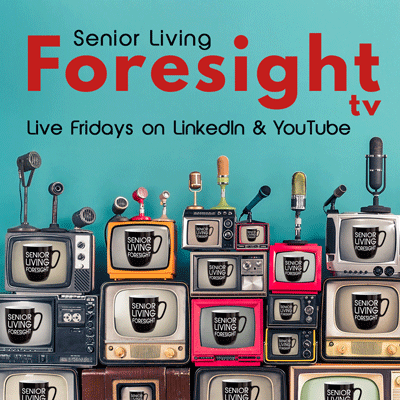By Jack Cumming
As the largest senior housing enterprise in the nation, Brookdale has the unique potential to promote residential living as an empowering life with purpose. Of course, anyone with vision and sufficient capital can potentially upend an industry. Examples abound of entrepreneurial disruption. Today, Brookdale has the resources to upend itself, lead the industry forward, and more. All it would take is vision and commitment.
Vision and Commitment
Brookdale’s future will be determined by how effectively the board supports change and how effectively the new leadership realizes the opportunity. Merely trying to milk the real estate for profit seems shortsighted. Succeeding in reshaping the industry will require bold thinking and experimentation with a quick eye to discern what works and what doesn’t.
To begin, no one is eager to move into an old folks’ home as an anteroom to the life hereafter. As one senior living industry leader said the other day, “We’re more like funeral homes than like resorts.” As the romance of single-family homes fades under the pitfalls it brings, people will begin to look for new living models. The opportunity exists to create convenient living with ownership, amenities, and benefits, including incidental support for aging.
In this article, I consider seven things that quickly come to mind that might work well for Brookdale and aging generally.
- Avoid stigmatizing old age. Eliminate formal age restrictions by opening residences to people of all ages and all health conditions, but with the availability of support for chronic health conditions if needed. A fitting slogan might be “Brookdale Better Living.” People don’t want to be made to feel old; they want to feel that they act younger than their age. Reality is a tough sale. Dreams make the sale.
- Lead with financial security, promoting a sound balance sheet as an advantage over many other senior living enterprises. Brookdale might innovate new living ideas, but finding those ideas might require moving corporate headquarters from the home of country music to a money center location.
- Embrace the emerging potentialities of technology, ranging from paper elimination to the development of automated service delivery. The senior living industry has lagged in technology, and it’s time for a dynamic enterprise to harness technology as a competitive advantage. Be the future, not the past. More to the point, the robots are coming. Be there first, as the emphasis shifts from humanoids to practical devices.
- Bring the staff and resident cultures into harmony. Residents and staff can work together to make living better. It should be all of us working together for better lives for all. As one worker said recently, “It shouldn’t be us against you. It should be all of us coming together.”
- Enhance the value, dignity, and personal choice for residents. Keep residential costs in line with general property management charges. Other services, like meal programs, can be priced as separate business profit centers. Residents can create individual bundles to realize commitment discounts.
- Supersede the not-for-profit mythology by publicizing the advantages of fairly priced residential living. Develop a conversion program to take financially weak or failing not-for-profits into Brookdale’s newly branded financial paradigm. This requires innovative thinking, but it should not be difficult.
- Develop a public awareness program, working with a creative media advisor, to promote Brookdale as the brand for quality, secure living with fewer daily living hassles. Match the delivery of services to the branding message to gain the momentum of credible word-of-mouth promotion.
A creative leader can bring forward ideas like these and many others to transform Brookdale much as Amazon supplanted Sears. Sears shut down its catalog operation in 1993. Amazon was founded in 1994 with the realization that the internet could be a mammoth mail-order catalog. Will Brookdale be Sears?
Emphasize Financial Security
That brings us to the elephant in the room. Brookdale is a publicly traded mega-corporation. Most of the senior living industry is dominated by not-for-profits, many of whom rely on IRS Revenue Ruling 72-124 for tax exemption. That should give the not-for-profits a value advantage, but that positive value is not evident in market-priced senior housing.
Instead, many not-for-profit enterprises ask prospects to give up home ownership to pay entrance fees, which are then used to fund corporate ownership. That’s perplexing for prospects with the financial savvy to question the rationale of a pitch that says, “You buy it, but we own it.”
A Precedent
I was living in New York City as it transitioned from a tenant rental housing culture to a cooperative ownership community. The benefits for former landlords and the city’s citizens were enormous. Brookdale’s corporate structure allows ownership possibilities that elude not-for-profits.
Incidentally, in contrast to condominiums, cooperatives allow a smooth transition when residents die. But there are other options: mutual corporations owned by their customers and even not-for-profits with residents as the corporate voting members.
The Not-for-profit Financial Disadvantage
Senior housing is capital-intensive, and lenders require an equity cushion to protect them from loss. In the investor-funded multi-family housing market, that cushion comes from investors who are fully aware of the risks they are undertaking. Security laws and risk-disclosure requirements also protect them.
That’s very different for not-for-profit senior housing. There, entrance fees are solicited under the contractual pretext that they result in reduced monthly fees for the rest of the investor’s life. Most often, those “investors” are never told that they are risk-absorbing speculators. They are just paying a large initial fee as prepaid consideration for a contract of lifelong benefits. That’s the same as an insured life annuity issued by a licensed and regulated insurance company.
As not-for-profits struggle financially, many with weak or upside-down balance sheets, a revivified Brookdale might be able to pick up bargains and rescue residents from devastation. There are legal and financial entanglements to consider, but developing a repeatable conversion model would not be difficult. Not long ago, much of the mutual life insurance industry converted to investor ownership. Conversion can benefit senior housing as well.
Public Awareness
Educating the public about the importance of financial security must be part of any branding campaign that new management undertakes. The public should properly fear trusting enterprises that don’t have strong balance sheets.
Let’s make aging natural again. Let’s make old age fun and fulfilling. Let’s find the talent to make it happen. And, if the talent won’t come to where Brookdale is, then Brookdale should go to the talent.
Which way will Brookdale now turn? What will distinguish its new direction?






Jack, it is much easier to sell a condo in NYC than a coop (as a former NYC coop owner and president of my coop board), and the seniors housing industry is not dominated by not-for-profits, only the CCRC sector. And why would Brookdale want to take over troubled not-for-profits when it is lagging behind their peers. Would be a big mistake and assumes thet Brookdale could fix the NFP when it can’t even fix itself. Jeeez
Your points are well-taken and deserve deep thought. Quick reactions: Condos offer owner benefits, but get tied up in estate settlements. With coops the proprietary lease can end at death, allowing reoccupancy, while only shares languish in estate settlements.
Next, yes, I was thinking CCRCs, but the larger industry has a trust challenge, and a quality national brand might bring credibility.
As for a national brand playing the savior for residents who would otherwise be tossed to the wolves (or, as in the case of a friend of mine whose CCRC went bust, to a tool shed in his daughter’s backyard), stories like that of my friend hurt everyone. Someone can benefit by buying at bargain basement prices and bringing the properties up to par with occupancy and reputation.
Still, these are just my superficial off-the-top-of-the-head thoughts, and this whole matter deserves a very deep dive among people with divergent perspectives to see if we can converge on something to make life in America the best there can be.